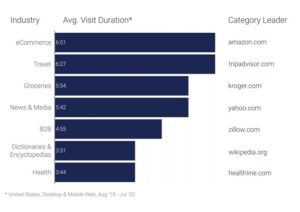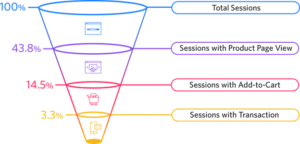More than nine out of 10 marketers and businesses see content as a valuable business asset with 56 percent of businesses planning to spend more on content creation in the immediate future, according to 2020 survey by Siege Media.
The inherent value of creating content is well understood, but many organizations still struggle to fully understand how to value the success of an individual piece of content. Two of the most used website metrics – Visit Duration and Conversion Rate – provide valuable information to content creators but also require a nuanced understanding to fully grasp.
Let’s look more at these tools in more detail, in particular how to determine their value based on context.
Visit Duration
Visit Duration, also known as Session Duration, can be one of the most interesting and challenging visitor metrics to analyze. This is due to the fact that the relevance of session duration is so closely tied to the business objective and varies so widely across industries and segments.
For example, an online survey in 2017 of 181 companies revealed that visitors to business-to-consumer companies spend on average 42.3 percent more time on site than visitors to business-to-business companies.

As you can see above, B2C categories such as eCommerce and travel command longer share of visitor attention than the B2B category. This is intuitive because B2B visitors typically expect vendors to “get to the point” and demand clear Information Architectures with crisp calls to action (CTAs) so they can quickly determine if the site they are visiting is appropriate for their immediate needs. By contrast, B2C visitors may linger and shop, compare pricing, read reviews and recommendations before making a purchase.
It’s easy to understand that the average session duration should decrease as customers proceed farther along their customer journey. Specifically, during the brand awareness phase, when a visitor is first being introduced to a brand, they may linger longer on pages, or visit multiple pages trying to learn more about a company, service or product.
However, as they enter the consideration and education phases of their customer journey, and their level of intent increases, they will desire to move more quickly through a site to achieve their intended goal. Thus, average session duration must not be “taken as a whole” with one aggregate value pertinent to every visit to the site, but rather leveraged to analyze whether customer journey-specific content is effectively moving visitors to our intended outcome.
This should be seen as true whether the company is selling sweaters or managed cybersecurity services.
If increasing the length of session duration is defined as a business objective (as there must be specific reasons to do so such as increases session duration directly correlates to increased conversions) then there are several tactics available to achieve this end.
- Include Videos. By leveraging video, you can present information more dynamically, allowing for more convenient multitasking.
- Break Up Text with Engaging Images. Content with custom graphics that help visualize statistics performs better in terms of session duration.
- Understand the Customer Journey. Think about where new content fits in the typical user journey—is it top-of-the-funnel content, or is it designed to convert returning visitors?
- Track the Right Metrics. Follow which pages have the lowest average time-on-page to identify the pages that need the most work.
- Make Sure Your Interface Is User-Friendly. A distraction-free experience focuses a reader’s attention on the article or web page instead of on closing pop-ups, ignoring ads or exploring a sidebar.
- Format Your Content so it’s Easy to Read. If it looks like it’s easy to scan through (descriptive subheads) visitors will spend a few seconds scrolling down.
- Link to Other Pages of Your Site. If people are interested in a topic, they will keep reading.
- Build a Library. Build a hub-and-spoke model that identifies a relevant, high-level topic then builds out articles on all related topics.
- Publish Content That’s Worth Reading. Provide on-point, exhaustive, accurate information that is easy to read and understand.
As with all web analytics metrics, there is no “one size fits all” session duration value. “Good” values will vary by industry, customer segment and even throughout the site itself.
Conversion Rate
Conversion Rate is a critical metric for web analytics because it is a representation of “where the rubber hits the road.” In other words, websites must exist to do something to further the needs of a business. And thus, conversion rates are the Key Performance Indicator most closely aligned with clearly defined business objectives. While many web metrics are technical in nature, indicative of site performance and so forth, conversion rates are indicative of the website’s ability (if not the entire digital ecosystem’s ability) to generate real business value.
Broadly defined, the website conversion rate shows the percentage of website visitors that take a desired action on your site. This action converts them from visitors to leads (or customers). The desired action might be downloading an ebook, signing up for a trial, completing a purchase, subscribing to a course, downloading a mobile app, booking a demo, or something else.
To properly understand conversion rates, one must properly understand what constitutes a conversion, which requires clear understanding and articulation of a goal, which can only be derived by clearly stated business objectives. For example, the very definition of a conversion rate “reads” like the business objective it is intended to convey:
“What percentage of visitors actually signed up for our newsletter after visiting the new services page?”
Conversion rate = newsletter signups / services page visitors
“What percentage of women ages 45-54 in Virginia bought wine after visiting from Facebook?”
Conversion rate = in-segment eCommerce transactions / Facebook referrals
Another critical aspect of “overall” conversion rates is the importance of “sub-conversion rates” and their ability to illustrate failed steps of the funnel path. For example, any overall conversion rate is the product of its stepwise conversion rates, as indicated below. Thus, not only must we have goals for the top-of-funnel to transaction conversion rate, but we must also have goals for each step of the way.

Typical conversion rates also vary widely by industry, and appropriate consideration must be paid when deriving strategy to ensure we are benchmarking against relevant competitive data sets.
Similarly, conversion rates will also vary widely depending on visitor state, for example new versus returning visitors. The way a first-time visitor interacts with a site is very different from how a returning visitor interacts.
To improve first-time visitors conversions, you have to isolate this metric from the conversion rates of your loyal or returning customers. See what they’re interested in when they visit the website for the first time and how you can improve that experience. When analyzing returning visitor conversion rates, there are two questions to be asked:
- Why did the person return?
- Did the person convert the first time around? And if not, how can you convert them the second time they visit your site?
Given the differences in conversion rates between new and returning visitors, conversion rate targets must be designed according to the customer journey. For example, many first-time visitors may be arriving at a site through brand awareness campaigns such as thought leadership pieces or organically finding blog articles, whereas returning visitors may have already progressed past brand awareness and are now in the consideration or education phase.
Many different techniques can be employed to engage these visitors with higher intent, possibly returning for their second, third or more visit, in order to drive conversions. Messaging with greater intensity and affinity must be deployed that urge a prospect to take action. Conversion rate analysis based on the same customer segment but identified to be at different stages of their journey can provide deep insight in content marketing and lead gen initiatives.





